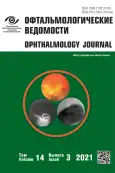Нейротрофическая кератопатия и синдром Валленберга – Захарченко: клинический случай
- Авторы: Эзугбая М.Б.1, Астахов С.Ю.1, Рикс И.А.1, Папанян С.С.1, Бутаба Р.1, Михальченко Ю.Г.2, Якушенко А.Р.1
-
Учреждения:
- Первый Санкт-Петербургский государственный медицинский университет им. акад. И.П. Павлова
- Клиника «Скандинавия», ООО «АВА-ПЕТЕР»
- Выпуск: Том 14, № 3 (2021)
- Страницы: 83-90
- Раздел: Клинические случаи
- URL: https://journals.rcsi.science/ov/article/view/79199
- DOI: https://doi.org/10.17816/OV79199
- ID: 79199
Цитировать
Аннотация
Актуальность. В 1824 г. F. Magendie впервые описал дегенеративные изменения роговицы после пересечения тройничного нерва. Нейротрофическая кератопатия считается орфанным заболеванием, которое в настоящее время диагностируют всё чаще. Частота встречаемости по данным литературы составляет 5 на 10 000 населения. Постановка диагноза вызывает сложности из-за недостаточности знаний о данной патологии, редкого возникновения и наличия большого количества этиологических факторов.
Цель — определить причины развития нейротрофической кератопатии и тактику лечения у пациента с неврологическим заболеванием.
В статье представлен случай развития нейротрофической кератопатии у пациента с синдромом Валленберга – Захарченко. Поскольку заболевание было поздно диагностировано и правильное лечение было начато несвоевременно, не удалось избежать дальнейшего прогрессирования патологического процесса в роговице. Периодическое обострение нейротрфической кератопатии связано с основным хроническим неврологическим заболеванием.
Заключение. Нейротрофическая кератопатия требует ранней диагностики. В определённых клинических случаях для успешного лечения данной патологии необходимо назначение системной терапии.
Полный текст
Открыть статью на сайте журналаОб авторах
Мэгги Бежановна Эзугбая
Первый Санкт-Петербургский государственный медицинский университет им. акад. И.П. Павлова
Автор, ответственный за переписку.
Email: maggie-92@mail.ru
ORCID iD: 0000-0002-0421-1804
аспирант кафедры офтальмологии с клиникой
Россия, 197022, Санкт-Петербург, Ул. Льва Толстого, 6-8Сергей Юрьевич Астахов
Первый Санкт-Петербургский государственный медицинский университет им. акад. И.П. Павлова
Email: astakhov73@mail.ru
ORCID iD: 0000-0003-0777-4861
SPIN-код: 7732-1150
доктор медицинских наук, профессор, заведующий кафедры офтальмологии с клиникой
Россия, 197022, Санкт-Петербург, ул. Льва Толстого, д. 6–8Инна Александровна Рикс
Первый Санкт-Петербургский государственный медицинский университет им. акад. И.П. Павлова
Email: riks0503@yandex.ru
ORCID iD: 0000-0002-5187-1047
SPIN-код: 4297-6543
кандидат медицинских наук, ассистент кафедры офтальмологии с клиникой
Россия, 197022, Санкт-Петербург, ул. Льва Толстого, д. 6–8Санасар Сурикович Папанян
Первый Санкт-Петербургский государственный медицинский университет им. акад. И.П. Павлова
Email: Dr.papanyan@yandex.ru
ORCID iD: 0000-0003-3766-2211
SPIN-код: 9794-4692
кандидат медицинских наук, врач-офтальмолог клиники офтальмологии
Россия, 197022, Санкт-Петербург, ул. Льва Толстого, д. 6–8Рафик Бутаба
Первый Санкт-Петербургский государственный медицинский университет им. акад. И.П. Павлова
Email: boutabarafik@yahoo.fr
ORCID iD: 0000-0002-3700-8255
клинический ординатор кафедры офтальмологии с клиникой
Россия, 197022, Санкт-Петербург, ул. Льва Толстого, д. 6–8Юлия Геннадьевна Михальченко
Клиника «Скандинавия», ООО «АВА-ПЕТЕР»
Email: erisod29@mail.ru
врач-офтальмолог
Россия, Санкт-ПетербургАлексей Романович Якушенко
Первый Санкт-Петербургский государственный медицинский университет им. акад. И.П. Павлова
Email: yakushenkoalex@yandex.ru
студент 6-го курса
Россия, 197022, Санкт-Петербург, ул. Льва Толстого, д. 6–8Список литературы
- Magendie F. De l’influence de la cinquieme paire de nerfs sur la nutrition et les fonctions de l’oeil // J Physiol Exp Pathol. 1824. Vol. 4. P. 176–182. (In French)
- Dua H.S., Said D.G., Messmer E.M., et al. Neuropathic Keratopathy. [Internet] Progress in Retinal and Eye Research, 2018. Доступ по ссылке: https://research.birmingham.ac.uk/portal/en/publications/neurotrophic-keratopathy(2478a374-6546-4972-a335-54590310c27c).html.DOI: 10.1016/j.preteyeres.2018.04.003
- Bonini S., Rama P., Olzi D., Lambiase A. Neurotrophic keratitis // Eye (Lond). 2003. Vol. 17. P. 989–995. doi: 10.1038/sj.eye.6700616
- Morishige N., Morita Y., Yamada N., et al. Congenital hypoplastic trigeminal nerve revealed by manifestation of corneal disorders likely caused by neural factor deficiency // Case reports in ophthalmology. 2014. Vol. 5. No. 2. P. 181–185. doi: 10.1159/000364899
- Lin X., Xu B., Sun Y., et al. Comparison of deep anterior lamellar keratoplasty and penetrating keratoplasty with respect to postoperative corneal sensitivity and tear film function // Graefe’s archive for clinical and experimental ophthalmology. 2014. Vol. 252. P. 1779–1787. doi: 10.1007/s00417-014-2748-6
- Wilson S.E., Ambrosio R. Laser in situ keratomileusis-induced neurotrophic epitheliopathy // Am J Ophthalmol. 2001. Vol. 132. No. 3. P. 405–406. doi: 10.1016/s0002-9394(01)00995-3
- Wasilewski D., Mello G.H., Moreira H. Impact of collagen crosslinking on corneal sensitivity in keratoconus patients // Cornea. 2013. Vol. 32. No. 7. P. 899–902. doi: 10.1097/ICO.0b013e31827978c8
- Lockwood A., Hope-Ross M., Chell P. Neurotrophic keratopathy and diabetes mellitus // Eye (Lond). 2006. Vol. 20. P. 837–839. doi: 10.1038/sj.eye.6702053
- Semeraro F., Forbice E., Romano V., et al. Neurotrophic keratitis // Ophthalmologica. 2014. Vol. 231. P. 191–197. doi: 10.1159/000354380
- Hsu H.Y., Modi D. Etiologies, Quantitative Hypoesthesia, and Clinical Outcomes of Neurotrophic Keratopathy // Eye Contact Lens. 2015. Vol. 41. No. 5. P. 314–317. doi: 10.1097/ICL.0000000000000133
- Mackie I.A. Neuroparalytic keratitis. In: F.T.Fraunfelder, F.H. Roy, J. Grove, editors. Current Ocular Therapy, 4 ed. W.B. Saunders. Philadelphia, 1995. P. 452–454.
- Рикс И.А., Папанян С.С., Астахов С.Ю., Новиков С.А. Новая клинико-морфологическая классификация эндотелиально-эпителиальной дистрофии роговицы // Офтальмологические ведомости. 2017. Т. 10, № 3. С. 46–52. doi: 10.17816/OV10346-52
- Астахов С.Ю., Новиков С.А., Папанян С.С., Рикс И.А. Оценка эффективности ускоренного коллагенового кросслинкинга в лечении эндотелиальной декомпенсации роговицы // Офтальмология. 2020. Т. 17, № 4. С. 699–704. doi: 10.18008/1816-5095-2020-4-699-704
- Mastropasqua L., Nubile M., Lanzini M., et al. In vivo microscopic and optical coherence tomography classification of neurotrophic keratopathy // J Cell Physiol. 2019. Vol. 234. No. 5. P. 6108–6115. doi: 10.1002/jcp.27345
- Kugadas A., Gadjeva M. Impact of Microbiome on Ocular Health // Ocul Surf. 2016. Vol. 14. No. 3. P. 342–349. doi: 10.1016/j.jtos.2016.04.004
- Ayaki M., Iwasawa A., Niwano Y. In vitro assessment of the cytotoxicity of six topical antibiotics to four cultured ocular surface cell lines // Biocontrol Sci. 2012. Vol. 17. No. 2. P. 93–99. doi: 10.4265/bio.17.93
- Bonini S., Lambiase A., Rama P., et al. Topical treatment with nerve growth factor for neurotrophic keratitis // Ophthalmology. 2000. Vol. 107. No. 7. P. 1347–1351. doi: 10.1016/s0161-6420(00)00163-9
- Yamada N., Matsuda R., Morishige N., et al. Open clinical study of eye-drops containing tetrapeptides derived from substance P and insulin-like growth factor-1 for treatment of persistent corneal epithelial defects associated with neurotrophic keratopathy // Br J Ophthalmol. 2008. Vol. 92. No. 7. P. 896–900. doi: 10.1136/bjo.2007.130013
- Guerra M., Marques S., Gil J.Q., et al. Neurotrophic Keratopathy: Therapeutic Approach Using a Novel Matrix Regenerating Agent // J Ocul Pharmacol Ther. 2017. Vol. 33. No. 9. P. 662–669. doi: 10.1089/jop.2017.0010
- Труфанов С.В. Применение цианоакрилатного клея в хирургическом лечении перфорации роговицы (клиническое наблюдение) // Вестник офтальмологии. 2020. Т. 136, № 5–2. С. 232–236. doi: 10.17116/oftalma2020136052232
Дополнительные файлы












